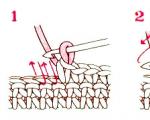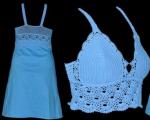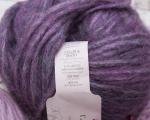Crochet patterns for blouses. Openwork crocheted blouses patterns, how to knit a white blouse
Of course, when it comes to knitted clothing, the hot summer favorites are tops. They can be divided into two types: either a knitted fabric with an emphasis on decor, or a bodice complemented by fabric. In modern fashion, crocheted bodices have become not a piece of clothing, but an independent element of the wardrobe. They are not hidden, on the contrary, attention is focused on them with decoration and originality of knitting. We propose to consider various ways of their implementation.

A few words about matings. They can be different, the main thing is density and the ability to maintain shape. SBN and C1H (single crochet stitches) are best suited.
For very small sizes, you can use a rectangular or triangular shaped fabric, knitted in different directions. See fig. for options. 1, 2, 3.

A rectangular fabric can be beautifully draped, tied with cords and this creates a convexity of the fabric. In triangular-shaped bodices, the volume is formed when tying: the edges of the fabric must be slightly pulled together with single crochets.
The triangle knitted according to pattern 1 has a convexity according to the knitting method. It can be increased by slightly pulling the bottom of the cup when tying the RLS. For sizes 44-46 the cup volume should be larger. In this case, knitting according to pattern 2 (photo 1) is suitable. It should be noted that the diagram reflects the knitting principle, but does not give actual dimensions. You must calculate the number of stitches and the number of rows of knitting according to your size and knitting density. Rows C1H can be of different colors if this matches the overall composition of the top. Stripes of different colors will highlight the shape of the cup. When knitting such a cup RLS (Diagram 3), the hook can be inserted traditionally under both half-loops, or it can be knitted behind the back wall. In the latter version, the canvas acquires relief.
Cups associated with horizontal or vertical darts are very convenient.
In the first case (diagram 4), it is necessary to calculate the number of sc for the widest part of the cup based on the density of knitting (measure along the bra), dial 6-8 sc less and add them when knitting the lower part of the cup. Knit the dart in partial knitting. In the proposed pattern, the “step” of partial knitting consists of 3 sc. In the first row of partial knitting (15th row of the pattern) do not knit 3 sc, make a ch for lifting, turn the knitting, knit a row and at the end of it (16th row according to the pattern) also do not knit the last 3 sc. Continue knitting in this way until 5-8 sc remain. A smaller number of RLS gives the cup a sharpness that is not needed in this version. Please note that the number of “steps” on each side should be the same. The result is half a cup, which you see in photo 2.
To avoid holes and creasing of the last sc of the “step”, knit as follows: insert the hook into the head of the last sc of the “step”, remove the working thread, but do not knit. Insert the hook behind the leg of the last SC of the previous row (photo 3), remove the RN and knit all the loops together. Usually knit the 3rd and 2nd sc of the next “step” (photo 4), and the last sc as described above. Having knitted to the end, turn the knitting and knit the next row in the same way. The result will be a smoothly rounded canvas (photo 5).
Continue knitting, decreasing one sc in each row on the right and left sides. Step back from the edge one sc at a time, it will be easier to tie. Continue knitting the last 4-5 sc evenly, this will be a strap. Look at photo 6 for a fully knitted cup. While knitting, try on the cup. If you think that it is not convex enough, change the number of sc in the “steps”, for example 3-2-3-2 or 2-2-2...
Knit a cup with vertical darts (photo 7) according to pattern 5. Its size can be adjusted by changing the initial number of VPs and the intensity of increases and decreases (two instead of one or alternating them). These cups look classic and fit almost all sizes. The width of the cup can be changed if necessary, decorating with lace or guipure elements.
A very popular option is knitting from the center with triangles (pattern 6, photo 8).

Cups with multi-colored stripes are especially impressive (see photo 9). Their small drawback is the limitation in the sizes at which they look good.
A very interesting way to knit cups using the “¾ square” principle. Its advantage is that there are many options.
Option one - the classic form according to Fig. 4, photo 10.
Knit the fabric of such a cup from the wide part of the AB upwards. Match the small sides and sew. On a cup top, place the seam under the bust or on top depending on your taste. You will get the same cup shape when knitting a square according to pattern 7.
Option two - Fig. 5: cast on VP along the BAB line and knit with increases in the middle of the fabric (point A). Align points B and sew the cup along a straight line BVB* to the top fabric. The central part of the fabric will look more interesting if it is knitted in a simple and fairly dense pattern, for example, with “flyers” according to pattern 8, or another at your discretion.
Option three - a cup in which one (Fig. 6) or every third of the canvas (Fig. 7) consists of a square motif will look impressive. In photo 11, the bodice is formed by three classically knitted squares from the center.
Option four - diagram 9. General view in photo 12. The same small square at the base of the cup. Knit the remaining 2/3 of the fabric with sc on both sides of the square without any increase.
Notice the dart at the bottom of the cup. Knit two or three of them depending on the size. The upper part of the cup can be knitted openwork, as in diagram 10. It is shown in close-up that a rounding is knitted on one side of the square.

Option five according to scheme 11. Look at the general view of the canvas in Fig. 8. This is how it will turn out when knitting from line AB up. To round the shape, knit the inside of the fabric in half-columns. On the right side of the fabric, knit decreases, and the upper part - partial knitting. The VG lines horizontally and vertically must be the same, they need to be sewn. Cups of this shape fit very comfortably on breasts of any size. If you want to have a beautiful product, but not knit a bodice, you can knit guipure elements and sew them on your favorite bra so that it is not visible. An openwork fabric sewn at the bottom will turn it into a spectacular top.
Lots of summer tops and T-shirts.








Handicraftsmen who know how to crochet open up almost endless creative possibilities. This simple tool allows you to create truly amazing things. The openwork crochet pattern is suitable for all types of knitting clothes, as well as for giving it a finished look. We invite you to familiarize yourself with a large selection of pattern patterns that will be ideal for a certain type of knitted items.
The emergence of knitting
Crocheting originated quite recently. Its strengthening and development was facilitated by the industrial revolution, which helped make creative material accessible to the public. The natural fibers used by our ancestors were quite difficult to obtain and process. With the advent of mechanisms for cleaning cotton and spinning thread, the process accelerated significantly and expensive threads became cheaper. Now they were no longer the privilege of rich ladies; even peasant women could use yarn.

Lace was extremely popular. The finest openwork, created by the caring hands of craftswomen, was very expensive. This allowed the poor to unite in artels and produce lace for income. During the famine in Ireland, needlewomen invented a new type of lace, which was called Irish. It consists of tiny parts that are combined in various ways into a single canvas of incredible beauty. A great variety of different motif schemes have been developed for this technique.

Nowadays crochet is very popular. Even schoolchildren can master this simple instrument. The main thing is to have a little patience and everything will work out! Even fashion designers do not shy away from delicate handwork. Every year their collections are replenished with new knitted models, as in the photo below.

Features of patterns
Even if you don't fully master the art of knitting, you can create incredible patterns using ordinary stitches and stitches. All patterns are conditionally divided:
- Embossed;
- Openwork.
Embossed ones are a dense canvas with a massive ornament. Openwork translated from French means “through, translucent.” This means that the openwork fabric must have through holes. They are used for knitting both light summer and winter items. Even dense yarn can create an openwork fabric.

To make winter clothes, they use threads from mohair, wool, and angora. It is advisable that they be combined with artificial fibers such as acrylic or polyamide. Such proximity will make the result of the work strong and durable, and will help calm the “prickly temper” of the wool.
When creating summer openwork, preference is given to natural cotton, linen, viscose, and silk. They will give the product lightness and tenderness, will be pleasant to the body and will not cause allergies.
Create a sample
Before starting work on a product, even experienced craftsmen try to knit small samples. They will help:
- “Get your hand” in executing the pattern;
- View the properties of the selected yarn and determine its compatibility with the pattern;
- Calculate the knitting density.
We invite you to familiarize yourself with the popular peacock tail pattern.

The rapport is 19 loops. Knitting is done according to the following pattern.

The diagram shows 38 air loops of the initial chain. Pick them up using a crochet hook. Don't forget that the size of the hook and the thickness of the yarn must match each other. Add three lifting air loops. In the fifth loop from the hook, work 4 double crochets. Work one double crochet into the sixth loop. The next 8 stitches are knitted through one loop. A bunch of 5 double crochets is again knitted into the next loop. The rapport is over, now you need to repeat exactly the same sequence to the end of the row. Please note that at the beginning of the row, the selected lifting loops replaced your double crochet. When performing the second repeat, the first bunch should consist of 5 columns, not 4. The first row is finished, and the fabric has acquired a wave-like shape.
In the second row you need to go up one loop and knit a single crochet over each stitch of the previous row. You also need to knit all even rows. The third row is performed according to the description of the first row. In the fifth row, make 5 instep stitches (they will replace the first double crochet stitch), add a chain stitch and knit a bunch of 3 triple crochet stitches separated by a chain stitch into the last stitch of the third row. Skip two stitches and work a double crochet stitch into the third stitch. Repeat 4 times. Skip 2 more loops and make a bun of 5 double crochets separated by chain loops. Knit a second repeat. Complete the even row with single crochets.
Vertical repeat consists of the 6 rows you just knitted. To continue knitting the fabric, you need to repeat vertical repeats until the desired length of the product is reached. You can use this openwork for a stole or scarf.

Due to the characteristic shape of the canvas, this pattern is also called “waves”. If the description raises questions for you, we recommend that you watch a video that clearly shows the knitting process.
Patterns for beginners
Even beginners can create simple openwork patterns; although they are easy to do, they give the canvas a neat and beautiful look. The following patterns are suitable for beginner needlewomen.
Grids and cells.



Such fabrics can be used for knitting summer tops or for tunics.

Diamonds, squares.



They are perfect for a summer blouse or dress, as well as for winter items - shawls, sweaters, cardigans.



Fans, waves, zigzags. They relate to the “peacock tail” pattern, which we examined in detail.



They will be an excellent background for both a large blanket or snood, and for a little princess’ dress.



For experienced knitters
For those who have mastered the art of crocheting to perfection, we can recommend the following openwork patterns:
Christmas trees and waves.


Used for finishing summer items.

Floral patterns.


It is impossible to imagine any woman’s wardrobe without various tops, T-shirts, and blouses. This is a universal type of women's clothing that allows you to create outfits for everyday work, free time, or a holiday outfit. In the proposed selection of models of knitted tops you will find models with patterns for knitters of different levels to make with their own hands - from beginners to experienced needlewomen. The models offered include both the latest fashion trends and classic options.
How does a top differ from other types of sweaters?
The name top comes from the English “top”, which means top. Thus, a top can be called any clothing for the upper half of the body. But clothing designers mean a more narrow concept by top. This term refers to the type of light women's blouses without sleeves or with short sleeves. Fashion designers have come up with such a huge number of options for this type of clothing that without some skill it’s easy to get confused. Crop top, spaghetti strap top, halter top, choli, V-neck top, tishotka, tank top, singlet, bandeau, alcoholic tank top, racer top... This is not a complete list of variations on the theme of a top for women. Knitted sweaters have always attracted the close attention of fashionistas and famous fashion designers. Light and openwork, crocheted or knitted, knitted tops are a great addition to your wardrobe. A feature of many top models is their tight silhouette. Knitwear, including hand-knitted ones, is ideal for creating such models. Summer top models are knitted from thin cotton or linen threads.
Blouse knitting techniques
It is preferable to knit summer tops with openwork patterns. Due to the openwork of the crocheted fabric, crocheted blouses are the most popular. There are many crochet techniques:
- fillet knitting. A common method of crocheting a product, which is an imitation of fillet-guipure embroidery on a mesh. The pattern is obtained by alternating stitches with different numbers of yarn overs and air loops.
- Irish lace. Irish crochet is considered a luxurious crochet technique. Also known as “guipure stacked lace” or “Irish chain guipure”. The technique consists of separately connected plant motifs, combined into a single canvas according to the pattern. You can connect tightly, or you can use air bridges.
- freeform. Very bright technique. Its author is considered to be knitter Prudence Mapston, and the translation of the name of the technique from English is “free form”, correctly describes the technique itself. Freeform combines different knitting techniques from Irish lace to freeform. Particularly impressive models are obtained when using yarn of different textures.
- Tatting. Crochet tatting imitates knot weaving using a tatting needle.
- broomstick. Another name for this technique is Peruvian. Knitted using two tools - a hook and a very thick knitting needle. Although there is a variation of making air loops with hook elements using only one hook.
- free knitting technique. The basis of random (irregular) knitting is Irish lace. The difference is that in Irish knitting and freeform, the motifs are knitted separately, with a thread broken, and with irregular knitting, one motif is knitted from another.
- Tunisian knitting. To make patterns using Tunisian or Afghan knitting techniques, you need a special long hook. The result is a dense, embossed fabric.
- ribbon lace technique. To knit blouses using this technique, ribbons of openwork semicircular lace motifs are knitted. The individual lace parts are sewn or crocheted into fabric according to the pattern.
- knitting using tapestry technique. The tapestry technique is based on knitting dense fabric with bright geometric patterns in columns.
- knitting using the Bruges lace technique. The Bruges technique imitates Bruges lace woven using bobbins. The design consists of three elements: motifs, braid and background grid.
Basic Crochet Patterns
It is difficult to determine the main patterns, because the patterns depend on the chosen technique. In Irish crocheted lace, the main patterns are plant motifs obtained by tying a thick structural thread.
Loin knitting is characterized by patterns reminiscent of cross stitch patterns. Depending on the craftswoman’s idea, the fabric turns out either dense or transparent, mesh.
Free knitting and ribbon lace are based on spherical motifs of columns and air loops.
Caring for knitted items
Knitted items require careful handling when washing. It is better to wash knitted items by hand, without stretching the product, and if in a washing machine, then only in a gentle mode. For washing, it is better to use soft powders, without the addition of bleaches and others. Turn the knitted blouse inside out before washing.
Knitted items should be dried on a horizontal surface, with a terry towel underneath, and spread out. Under no circumstances should you dry knitted items on hangers. If the item requires ironing, then iron it in the steam mode. Store things in the closet folded. Do not stack high piles - the sweaters located below will be compressed under the weight of other clothes.
How to choose yarn
Knitting patterns for patterns must include instructions for choosing yarn. If you are using a different type of thread, before starting work, knit a sample of the pattern with the selected material in order to correctly calculate the size and number of loops. When choosing yarn, be sure to read the skein label, which indicates the composition, weight and length of the thread in the skein. Buy yarn with a reserve, because in case of shortage it is difficult to find the same ones. From the remaining yarn, when a sufficient amount has accumulated, you can knit original things, or use the leftovers for children's clothes.
Relaxing in nature or walking around the city, working in an office without a strict dress code and even visiting the theater - everywhere a handicraft of decent quality and a suitable style will be appropriate and will attract attention.
Jackets and sweaters can be knitted:
- solid fabric with different patterns (including jacquard);
- separate motifs connected in a certain sequence or randomly (“Irish lace”);
- in Bruges style.
Preparatory stage of knitting sweaters and jackets:
The choice of yarn composition and thickness depends on the intended model. You can knit from wool, acrylic, cotton, linen, blended and even thick “knitted” yarn.
Delicate silk (artificial and natural), viscose, bamboo fiber, thanks to crocheting, better “keep their shape”, but if necessary, they drape perfectly.
It is advisable to choose yarn that is not very twisted. But this is not an absolute ban. You just have to interrupt the knitting, fasten the thread and let the piece straighten out while hanging.
The material of the tool (metal, wood, plastic), the shape of the handle and head do not play a special role. Each needlewoman has her own preferences. The main thing is that the hook fits comfortably in your hand and does not have “burrs” that scratch your hands and yarn. Then the knitting process will be a joy. In addition to the usual short ones (up to 16 cm), there are long hooks (usually 30 cm) for the so-called Tunisian knitting.
Kaleidoscope of jacket and blouse designs
The variety of crochet techniques allows you to create women's jackets and blouses that can be combined with almost any wardrobe item. The style can be straight or fitted (by changing the hook to a smaller one or making darts).
When using a dense pattern that imitates tweed material, Chanel-style products are created. This stylish item can be combined with a pencil skirt, sheath dress, or classic trousers.
An original crocheted transformable jacket is often crocheted on the basis of a round napkin or tablecloth. Holes are left in place of the armholes, and the sleeves are subsequently knitted or sewn on. Charming patterns and rounded fronts turn this jacket into a top-class model for beauties with unique taste.
As the great trendsetter said: “Lace is the most beautiful imitation of nature’s fantasy.” Crocheted jackets and sweaters made with graceful openwork weaves look extremely feminine. Lace models fit harmoniously into a multi-layered style.
Often several patterns are combined in one model. In everyday life, adding knitted items to your look even adds a romantic charm to jeans.
Convenient techniques for recycling leftover yarn are knitting with raglan on top, or with motifs. At the same time, the likelihood of encountering an identical item on someone is minimal.
Knitting from idea to implementation is a fascinating process. All that remains is to find time for a useful hobby.



